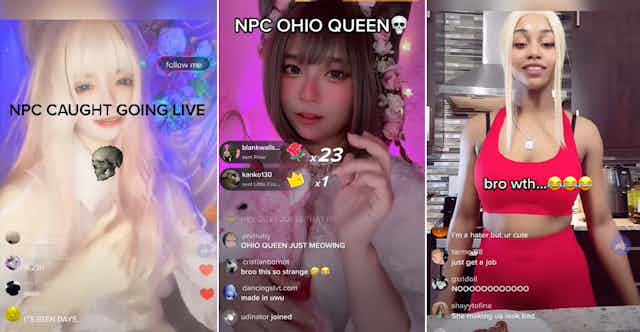“Yes, yes… mmm, mmm ice cream so good,” coos a platinum-haired woman known on TikTok as Pinkydoll. Holding a hair straightener, she plays with popcorn kernels and audibly pops her lips. Your screen brightens with emojis of food, roses and stars purchased by her audience. What are we watching? Why?
Pinkydoll is a Montréal-based social media creator who has become the face of TikTok’s latest trend: NPC streaming. The trend draws its name from the non-playable characters (NPCs) of video games. Think of background characters that might perform a few preprogrammed lines or actions.
NPC streamers perform a cycle of non-sequitur dialogue, cartoonish stares and physical jolts for no purpose besides ambience in a virtual world. In July 2023, videos featuring creators like Pinkydoll — mostly thin, conventionally attractive women — went viral to the confusion of millions.
Top content creators can earn thousands of dollars a day online. With this trend, more TikTokers have found incentive to become living game pieces for a digital public. Pinkydoll credits the backgrounds citizens of the Grand Theft Auto video game as the inspiration for her performances.
Some touted NPC-ing as a triumph for “fetish videos.” Others argue that labelling NPC content as “fetish” expands digital surveillance and moral panic against sex workers.
A number of popular NPC streamers also produce paywalled adult content on sites like OnlyFans. The rise of NPC streaming showcases how gamer cultures and adult content make for lucrative bedfellows.
Livestreamers as our ‘playthings’
Livestreaming represents an increasingly vital part of the social media business models of companies like YouTube and Instagram. Their apps offer an easy interface between broadcasters and audiences, who interact with each other in real-time via voice and chat.
TikTok offers live video streaming to users with at least 1,000 followers. NPC streamers are thus already established creators familiar with commodifying our attention.
NPC streaming depends on the purchase and posting of “gifts.” Buying an NPC streamer a virtual gift triggers a chain reaction of the absurd: the gift will appear in a creator’s stream as emojis like ice cream cones, balloons, or even squids. NPC streamers then react accordingly to the specific image on their screen. Squeals, catchphrases, lip smacking and a myriad of gestures result. These broadcasts offer built-in incentives to keep engagement going.
Scholars have previously used “gift economy” to describe the unpaid rewards that prompt us to share with each other (for example, writing fan fiction without remuneration). In NPC streaming, not only is gifting tied to real-world currency; but gifts incite the streamer to move.
TikTok’s transactional approach to intimacy is not new. Amazon’s Twitch platform remains an exemplary case of a streaming platform that sells live interaction, with more than seven million active streamers. Dominated by professional gamers, Twitch operates a similar model where viewers accrue Channel Points for as long as they are watching a stream. With Channel Points, users can buy special emojis to be used in chats. They can also be redeemed to purchase subscriptions, which put real money in streamers’ pockets.
The parallels between livestreaming and webcam work have just begun to be academically recognized. Like the NPCs of TikTok, Twitch gamers render their bodies as intimate interfaces. As reflected by one Twitch streamer’s advice for colleagues, it is not uncommon for game streamers to set a “Bathroom Break” and “Hydration Break” as “achievements” (or commands) that viewers can purchase for their streamer to perform on demand.
Game streamers like Ludwig Ahgren have taken the sale of control further. In 2021, the Twitch creator broke records with a 31-day continuous livestream from his home. For every subscription received, Ahgren would extend the livestream by 10 seconds, leading to over US$1.4 million from those who subscribed.
In this context, NPC streamers are just the latest genre of creators who divide their bodies into marketplaces of intimacy.
What’s new is old in gamer patriarchy
With their predilection for shocking wigs, filters and revealing outfits, NPC streamer aesthetics bear a stark familiarity to the archetypes of controversial gamer “e-girls”: a once sexist slur from eSports that women gamers have reclaimed for themselves in recent years. Like e-girls, NPC streamers have been received as anti-heroines who have gamed our eyeballs into profit.
When women gain our attention for money, we pay attention to the figures. The media fixation on Pinkydoll echoes back specifically to the scandalous reaction to e-girl creator Belle Delphine who made headlines in 2017 for selling her own “Gamer Girl” bathwater for US$30 a bottle.
Similarly, many commentators have quoted the US$7,000 per day Pinkydoll has earned from streaming. However, TikTok alone did not pay her bills. According to the creator, the money is a collective sum from her streaming and adult content.
The economics of online fame are closely tied to a more invisible economy of online sex work. This is happening as the internet becomes increasingly unkind to erotic content creators. Anti-sex work movements such as the FOSTA-SESTA legislation in the U.S. and Meta’s purges of kink accounts are linked to growing online hostility toward those who sell intimacy, regardless of if they identify as sex workers.
In gamer cultures, a similar paranoia pervades against women seen to be “weaponizing” their sexuality. Twitch’s female game streamers operate in the shadow of the 2014 GamerGate harassment campaign.
NPC streaming gives creators a new avenue to earn money online. Understanding how different bodies, practices and agencies are received — and strategically surrendered — is essential to building safer play and work in social media.

